Portal:Scotland/Selected articles
| Main Page | Selected articles 1 | Selected articles 2 | Selected biographies | Selected quotes | Selected pictures | Featured Content | Categories & Topics |
Selected articles 1 through 60
Selected articles 1
Portal:Scotland/Selected articles/1

The
From the late 15th century the ideas of
Selected articles 2
Portal:Scotland/Selected articles/2

Recent research has shown that Doune Castle was originally built in the thirteenth century, then probably damaged in the
Selected articles 3
Portal:Scotland/Selected articles/3

The Falkirk Wheel (Scottish Gaelic: Cuibhle na h-Eaglaise Brice) is a rotating boat lift in Tamfourhill, Falkirk, in central Scotland, connecting the Forth and Clyde Canal with the Union Canal. It reconnects the two canals for the first time since the 1930s. It opened in 2002 as part of the Millennium Link project.
The plan to regenerate
The wheel raises boats by 24 metres (79 ft), but the Union Canal is still 11 metres (36 ft) higher than the aqueduct which meets the wheel. Boats must also pass through a pair of locks between the top of the wheel and the Union Canal. The Falkirk Wheel is the only rotating boat lift of its kind in the world, and one of two working boat lifts in the United Kingdom, the other being the Anderton Boat Lift.
Selected articles 4
Portal:Scotland/Selected articles/4

and a salt-water shower.
There is one village on the island,
Selected articles 5
Portal:Scotland/Selected articles/5
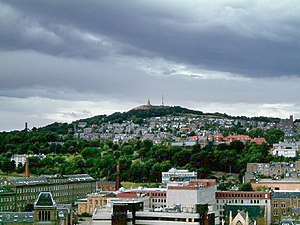
Today, Dundee is promoted as "One City, Many Discoveries" in honour of Dundee's history of scientific activities and of the RRS Discovery, Robert Falcon Scott's Antarctic exploration vessel, which was built in Dundee and is now berthed at Discovery Point. Biomedical and technological industries have arrived since the 1980s, and the city now accounts for 10% of the United Kingdom's digital entertainment industry, including mobile app development and gaming. Dundee has two universities – the University of Dundee and Abertay University. In 2014, Dundee was recognised by the United Nations as the UK's first UNESCO City of Design for its diverse contributions to fields including medical research, comics and video games.
With the decline of traditional industry, the city has adopted a plan to regenerate and reinvent itself as a cultural centre. In pursuit of this, a £1 billion master plan to regenerate and to reconnect the Waterfront to the city centre started in 2001 and is expected to be completed within a 30-year period. The
Selected articles 6
Portal:Scotland/Selected articles/6

Recognised as the capital of Scotland since at least the 15th century, Edinburgh is the seat of the
The city is a cultural centre, and is the home of institutions including the
Selected articles 7
Portal:Scotland/Selected articles/7

The
The Royal Botanic Garden Edinburgh is an
The Edinburgh botanic garden was founded in 1670 at St. Anne's Yard, near Holyrood Palace, by Robert Sibbald and Andrew Balfour. It is the second oldest botanic garden in the UK after Oxford's. The plant collection used as the basis of the garden was the private collection of Sir Patrick Murray, 2nd Lord Elibank, moved from his home at Livingston Peel in 1672 following his death in September 1671. The original site was "obtained of John Brown, gardener of the North Yardes in the Holyrood Abby, an inclosure of some 40 foot of measure every way. By what we procured from Levingstone and other gardens, we made a collection of eight or nine hundred plants yr." This site proved too small, and in 1676 grounds belonging to Trinity Hospital were leased by Balfour from the City Council: this second garden was sited just to the east of the Nor Loch, down from the High Street.
Selected articles 8
Portal:Scotland/Selected articles/8
The
The order's primary emblem is the
Selected articles 9
Portal:Scotland/Selected articles/9

The
The original Parliament of Scotland was the national legislature of the independent Kingdom of Scotland and existed from the early 13th century until the Kingdom of Scotland merged with the Kingdom of England under the Acts of Union 1707 to form the Kingdom of Great Britain. As a consequence, the Parliament of Scotland ceased to exist, while the Parliament of England, which sat at Westminster, was subsumed into the Parliament of Great Britain. In practice, all of the traditions, procedures, and standing orders of the English parliament were retained, with the addition of Scottish members in both the Commons and Lords.
Following a referendum in 1997, in which the Scottish electorate voted for devolution, the powers of the devolved legislature were specified by the Scotland Act 1998. The Act delineates the legislative competence of the Parliament – the areas in which it can make laws – by explicitly specifying powers that are "reserved" to the Parliament of the United Kingdom. The Scottish Parliament has the power to legislate in all areas that are not explicitly reserved to Westminster. The UK Parliament retains the ability to amend the terms of reference of the Scottish Parliament, and can extend or reduce the areas in which it can make laws. The first meeting of the new Parliament took place on 12 May 1999.
Selected articles 10
Portal:Scotland/Selected articles/10

On 14 October 1939, Royal Oak was anchored at
Selected articles 11
Portal:Scotland/Selected articles/11
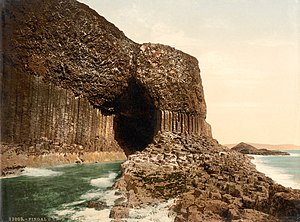
Staffa lies about 10 kilometres (6 miles) west of the Isle of Mull; its area is 33 hectares (82 acres) and the highest point is 42 metres (138 feet) above sea level.
The island came to prominence in the late 18th century after a visit by
In prehistoric times (Pleistocene) Staffa was covered by the ice sheets which spread from Scotland out into the Atlantic Ocean beyond the Outer Hebrides. After the last retreat of the ice around 20,000 years ago, sea levels were up to 125 metres (410 ft) lower than at present. Although the isostatic rise of land makes estimating post-glacial coastlines a complex task, around 14,000 years ago it is likely that Staffa was part of a larger island, just off the coast of mainland Scotland, which would have included what are now Mull, Iona and the Treshnish Isles.
Selected articles 12
Portal:Scotland/Selected articles/12
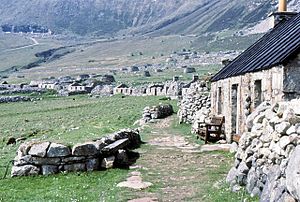
The origin of the name St Kilda is a matter of conjecture. The islands' human heritage includes numerous unique architectural features from the historic and prehistoric periods, although the earliest written records of island life date from the
Permanent habitation on the islands possibly extends back two millennia, the population probably never exceeding 180; its peak was in the late 17th century. The population was 112 in 1851. According to the 1861 census, there were 71 inhabitants at that time; over subsequent years, the population ebbed and waned, eventually dropping to 36 as of May 1930. Virtually all of the population lived on Hirta. The entire remaining population was evacuated from Hirta, by then the only inhabited island, in 1930.
Selected articles 13
Portal:Scotland/Selected articles/13
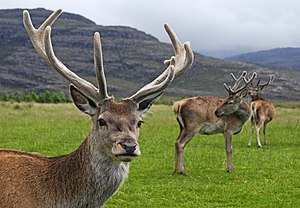
The
Many populations of
Scotland's seas are among the most biologically productive in the world; it is estimated that the total number of Scottish marine species exceeds 40,000. The Darwin Mounds are an important area of deep sea cold water coral reefs discovered in 1998. Inland, nearly 400 genetically distinct populations of Atlantic salmon live in Scottish rivers. Of the 42 species of fish found in the country's fresh waters, half have arrived by natural colonisation and half by human introduction.
Selected articles 14
Portal:Scotland/Selected articles/14

The
Pictish society was typical of many early medieval societies in northern Europe and had parallels with neighbouring groups. Archaeology gives some impression of their culture. Medieval sources report the existence of a
Selected articles 15
Portal:Scotland/Selected articles/15

Dunnottar is best known as the place where the
The ruins of the castle are spread over 1.4 hectares (3+1⁄2 acres), surrounded by steep cliffs that drop to the
Selected articles 16
Portal:Scotland/Selected articles/16
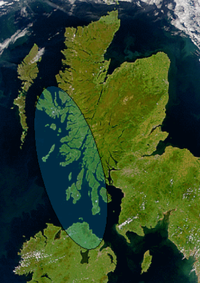
Dál Riata or Dál Riada (also Dalriada) (/dælˈriːədə/) was a Gaelic kingdom that encompassed the western seaboard of Scotland and north-eastern Ireland, on each side of the North Channel. At its height in the 6th and 7th centuries, it covered what is now Argyll ("Coast of the Gaels") in Scotland and part of County Antrim in Northern Ireland. After a period of expansion, Dál Riata eventually became associated with the Gaelic Kingdom of Alba.
In Argyll, it consisted of four main
Dál Riata is said to have been founded by the legendary king
Selected articles 17
Portal:Scotland/Selected articles/17

The Forth Bridge is a cantilever railway bridge across the Firth of Forth in the east of Scotland, 9 miles (14 kilometres) west of central Edinburgh. Completed in 1890, it is considered a symbol of Scotland (having been voted Scotland's greatest man-made wonder in 2016), and is a UNESCO World Heritage Site. It was designed by English engineers Sir John Fowler and Sir Benjamin Baker. It is sometimes referred to as the Forth Rail Bridge (to distinguish it from the adjacent Forth Road Bridge), although this is not its official name.
Construction of the bridge began in 1882 and it was opened on 4 March 1890 by the
The bridge and its associated railway infrastructure are owned by Network Rail.
Selected articles 18
Portal:Scotland/Selected articles/18
The city is a member of the
Glasgow grew from a small rural settlement close to
Selected articles 19
Portal:Scotland/Selected articles/19
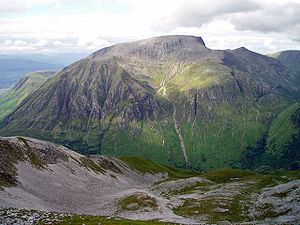
The mountain is a popular destination, attracting an estimated 130,000 ascents a year, around three-quarters of which use the Mountain Track from Glen Nevis. The 700-metre (2,300 ft) cliffs of the north face are among the highest in Scotland, providing classic scrambles and rock climbs of all difficulties for climbers and mountaineers. They are also the principal locations in Scotland for ice climbing.
The summit, which is the collapsed dome of an ancient
Selected articles 20
Portal:Scotland/Selected articles/20

Players induce a curved path, described as curl, by causing the stone to slowly rotate as it slides. The path of the rock may be further influenced by two sweepers with brooms or brushes, who accompany it as it slides down the sheet and sweep the ice in front of the stone. "Sweeping a rock" decreases the friction, which makes the stone travel a straighter path (with less curl) and a longer distance. A great deal of strategy and teamwork go into choosing the ideal path and placement of a stone for each situation, and the skills of the curlers determine the degree to which the stone will achieve the desired result.
Selected articles 21
Portal:Scotland/Selected articles/21

Single malt Scotch refers to single malt whisky made in Scotland. To qualify for this category, a whisky must have been distilled at a single distillery using a pot still distillation process and made from a mash of malted barley. Therefore, a single malt means that the whisky has not been blended elsewhere with whisky from other distilleries. As with any Scotch whisky, a single malt Scotch must be distilled in Scotland and matured in oak casks in Scotland for at least three years, although most single malts are matured longer.
- "Malt" indicates that the whisky is distilled from a "malted" barley. Malting calls for soaking the grains in water for several days until it germinates. Heat is then applied to stop the germination, often using peat as the fuel. Other grains, such as rye or wheat, can be malted for other types of whisky, but barley must be used for single malt Scotch. The dry malt is ground into flour (grist) and mixed with hot water; this mashing process converts the starch into sugar. Later, yeast is added to increase the process of fermentation. Finally, impurities such as methanol are removed during distillation; that also increases the alcohol content.
- "Single" indicates that all the spirits in the bottle come from a single distillery. That distillery may combine single malt whiskies of several ages in a bottle.
Until the Scotch Whisky Regulations 2009 (SWR 2009), the word "blended" only appeared (in the context of Scotch whisky) on bottles of whisky that contained a mixture of both barley and non-barley grain whisky, but this is no longer the case. Under the terminology established by the SWR 2009, the term "blended malt Scotch whisky" replaced the term "vatted malt" to describe a mixture of single malt Scotch whiskies (malted barley whisky).
Only about 10% of the Scotch whiskies on the market are defined as single malt. The other 90% is made by combining numerous whiskies, typically two-thirds grain whisky (non-barley) and one-third malt whisky, from several, or numerous, distilleries in Scotland. The resulting products are labeled "blended Scotch whisky", without the word "malt". Nearly 90% of Scotch whisky sold each year is a blended type. Nonetheless, in 2018, single malt Scotch made up nearly 28% of the £4.7 billion of whisky exported from Scotland.
Selected articles 22
Portal:Scotland/Selected articles/22

After the
Cutty Sark is listed by
Selected articles 23
Portal:Scotland/Selected articles/23
The Palace of Holyroodhouse (
The Palace adjoins Holyrood Abbey, and the gardens are set within Holyrood Park. The King's Gallery was converted from existing buildings at the western entrance to the Palace and was opened in 2002 to exhibit works of art from the Royal Collection.
King Charles III spends one week in residence at Holyroodhouse at the beginning of summer, where he carries out a range of official engagements and ceremonies. The 16th-century historic apartments of Mary, Queen of Scots, and the State Apartments, used for official and state entertaining, are open to the public throughout the year, except when members of the royal family are in residence. The Palace also serves as the official residence of the Lord High Commissioner to the General Assembly of the Church of Scotland during the annual meeting of the General Assembly.
Selected articles 24
Portal:Scotland/Selected articles/24

.
Aberdeen is one of Scotland's 32 local government council areas (as Aberdeen City), and has a population estimate of 198,590 for the city, making it the United Kingdom's 39th most populous built-up area, and 227,430 for the wider council area including outlying localities. The city is 93 mi (150 km) northeast of Edinburgh and 398 mi (641 km) north of London, and is the northernmost major city in the United Kingdom. Aberdeen has a long, sandy coastline and features an oceanic climate, with cool summers and mild, rainy winters.
During the mid-18th to mid-20th centuries, Aberdeen's buildings incorporated locally quarried grey granite, which may sparkle like silver because of its high mica content. Since the discovery of North Sea oil in 1969, Aberdeen has been known as the offshore oil capital of Europe. Based upon the discovery of prehistoric villages around the mouths of the rivers Dee and Don, the area around Aberdeen has been thought to have been settled for at least 6,000 years.
Selected articles 25
Portal:Scotland/Selected articles/25

The
The system is not the oldest underground railway in Glasgow: that distinction belongs to a three-mile (five-kilometre) section of the Glasgow City and District Railway opened in 1886, now part of the North Clyde Line of the suburban railway network, which runs in a tunnel under the city centre between High Street and west of Charing Cross. Another major section of underground suburban railway line in Glasgow is the Argyle Line, which was formerly part of the Glasgow Central Railway.
Selected articles 26
Portal:Scotland/Selected articles/26

Edinburgh Castle is a historic castle in Edinburgh, Scotland. It stands on Castle Rock, which has been occupied by humans since at least the Iron Age. There has been a royal castle on the rock since at least the reign of Malcolm III in the 11th century, and the castle continued to be a royal residence until 1633. From the 15th century, the castle's residential role declined, and by the 17th century it was principally used as a military garrison. Its importance as a part of Scotland's national heritage was recognised increasingly from the early 19th century onwards, and various restoration programmes have been carried out over the past century and a half.
Edinburgh Castle has played a prominent role in
Selected articles 27
Portal:Scotland/Selected articles/27

The Queensferry Crossing (formerly the Forth Replacement Crossing) is a road bridge in Scotland. It was built alongside the existing Forth Road Bridge and the Forth Bridge. It carries the M90 motorway across the Firth of Forth between Edinburgh, at South Queensferry, and Fife, at North Queensferry.
Proposals for a second Forth Road crossing, to meet unexpected demand, were first put forward in the 1990s, but no action was taken until structural issues were discovered in the Forth Road Bridge in 2004. In 2006–07 Transport Scotland carried out a study, and in December 2007 decided to proceed with a replacement bridge. The following year it was announced that the existing bridge would be retained as a public transport link. The Forth Crossing Act received royal assent in January 2011. In April 2011, the Forth Crossing Bridge Constructors consortium was awarded the contract, and construction began in late summer/autumn of 2011.
The Queensferry Crossing is a three-tower cable-stayed bridge, with an overall length of 2.7 kilometres (1.7 miles). Around 4 kilometres (2.5 miles) of new connecting roads were built, including new and upgraded junctions at Ferrytoll in Fife, South Queensferry and Junction 1A on the M9.
Selected articles 28
Portal:Scotland/Selected articles/28

The Rosslyn Chapel, formerly known as the Collegiate Chapel of Saint Matthew, is a 15th-century Scottish Episcopal Church chapel located in the village of Roslin, Midlothian, Scotland.
The Chapel is dedicated to
Sinclair founded the college to celebrate the
After the Scottish Reformation (1560), Catholic worship in the chapel was brought to an end. The Sinclair family continued to be Catholics until the early 18th century. Of note, while the Sinclair (surname) has its origins in Scotland, it is actually a derivation of the French surname de Saint-Clair.
Selected articles 29
Portal:Scotland/Selected articles/29

The recorded history of
The Gaelic kingdom of
The Kingdom of Scotland was united under the
Selected articles 30
Portal:Scotland/Selected articles/30

Hadrian's Wall marked the boundary between
Selected articles 31
Portal:Scotland/Selected articles/31

The flora of Scotland is an assemblage of native plant species including over 1,600 vascular plants, more than 1,500 lichens and nearly 1,000 bryophytes. The total number of vascular species is low by world standards but lichens and bryophytes are abundant and the latter form a population of global importance. Various populations of rare fern exist, although the impact of 19th-century collectors threatened the existence of several species. The flora is generally typical of the north-west European part of the Palearctic realm and prominent features of the Scottish flora include boreal Caledonian forest (much reduced from its natural extent), heather moorland and coastal machair. In addition to the native species of vascular plants there are numerous non-native introductions, now believed to make up some 43% of the species in the country.
There are a variety of important trees species and specimens; a
Selected articles 32
Portal:Scotland/Selected articles/32

Traditionally the home of
.Selected articles 33
Portal:Scotland/Selected articles/33

The
Sharing the humanist and rational outlook of the Western Enlightenment of the same time period, the thinkers of the Scottish Enlightenment asserted the importance of human reason combined with a rejection of any authority that could not be justified by reason. In Scotland, the Enlightenment was characterised by a thoroughgoing empiricism and practicality where the chief values were improvement, virtue, and practical benefit for the individual and society as a whole.
Among the fields that rapidly advanced were philosophy, political economy, engineering, architecture, medicine, geology, archaeology, botany and zoology, law, agriculture, chemistry and sociology. Among the Scottish thinkers and scientists of the period were
.Selected articles 34
Portal:Scotland/Selected articles/34

The Forth Road Bridge is a suspension bridge in east central Scotland. The bridge opened in 1964 and at the time was the longest suspension bridge in the world outside the United States. The bridge spans the Firth of Forth, connecting Edinburgh, at South Queensferry, to Fife, at North Queensferry. It replaced a centuries-old ferry service to carry vehicular traffic, cyclists and pedestrians across the Forth; railway crossings are made by the nearby Forth Bridge, opened in 1890.
The Scottish Parliament voted to scrap tolls on the bridge from February 2008. The adjacent Queensferry Crossing was opened in August 2017 to carry the M90 motorway across the Firth of Forth, replacing the Forth Road Bridge which had exceeded its design capacity. At its peak, the Forth Road Bridge carried 65,000 vehicles per day.
The Forth Road Bridge was subsequently closed for repairs and refurbishment. It reopened in February 2018, now redesignated as a dedicated Public Transport Corridor, with access to motor vehicles other than buses and taxis restricted; pedestrians and cyclists are still permitted to use the bridge. In May 2023,
Selected articles 35
Portal:Scotland/Selected articles/35

The
The newly identified piece, a "warder", the equivalent of a rook, was sold for £735,000 in July 2019. Four other major pieces, and many pawns, remain missing from the chess sets.
Selected articles 36
Portal:Scotland/Selected articles/36

The island has several Neolithic burial chamber sites, as well as the remains of Duke Hakon's 13th-century house dating from the Norse occupation of the island. The population reached 380 or more in the nineteenth century, when a fishing station was opened at Crabbaberry in West Voe. Subsequently, there was a steady decline in population.
Today the main settlement on the island is
Selected articles 37
Portal:Scotland/Selected articles/37

As the cathedral grew, so did the number of clerics and craftsmen. The repairs following the 1270 and 1390 fires resulted in the doubling in length of the choir and the provision of outer aisles to both the nave and choir. Today, some parts of walls reach their full height while others are at foundation level, but the overall cruciform shape is still discernible. A mostly intact octagonal chapter house dates from the major enlargement after the fire of 1270. The gable wall above the double door entrance that links the west towers is nearly complete and was rebuilt after the fire of 1390. It accommodates a large window opening that now only contains stub tracery work and fragments of a large rose window. The transepts and the south aisle of the choir contain recessed and chest tombs with effigies of bishops and knights. The now grass-covered floor bears large flat slabs that mark the positions of early graves. The residences of the dignitaries, canons and chaplains that stood in the chanonry were also destroyed by the fires of 1270, 1390 and 1402 forming part of the reconstruction process. Only the precentor's manse is substantially intact, while two others have been incorporated into private buildings. Both west front towers are mostly complete and were part of the initial construction. A protective wall of massive proportions surrounded the cathedral precinct, but only two small sections have survived. The wall had four access gates but only one, the Pans Port, still exists.
Selected articles 38
Portal:Scotland/Selected articles/38

The
The existing
Scotland has also had a role to play in many significant discoveries such as plate tectonics and the development of theories about the formation of rocks and was the home of important figures in the development of the science including James Hutton (the "father of modern geology"), Hugh Miller and Archibald Geikie. Various locations such as 'Hutton's Unconformity' at Siccar Point in Berwickshire and the Moine Thrust in the northwest were also important in the development of geological science.
Selected articles 39
Portal:Scotland/Selected articles/39

The
Plans for a bridge over the Tay to replace the train ferry service emerged in 1854, but the first Tay Bridge did not open until 1878. It was a lightweight lattice design of relatively low cost with a single track. On 28 December 1879, the bridge suddenly collapsed in high winds while a train was crossing, killing everybody on board. The incident is one of the worst bridge-related engineering disasters in history. An enquiry determined that the bridge was insufficiently engineered to cope with high winds.
It was replaced by a second bridge constructed of iron and steel, with a double track, parallel to the remains of the first bridge. Work commenced on 6 July 1883 and the bridge opened in 1887. The new bridge was subject to extensive testing by the Board of Trade, which resulted in a favourable report. In 2003, the bridge was strengthened and refurbished, winning a British Construction Industry Engineering Award to mark the scale and difficulty of the project.
Selected articles 40
Portal:Scotland/Selected articles/40

The east end of the abbey was completed in 1146. Other buildings in the complex were added over the next 50 years. The abbey was built in the Gothic manner and in the form of a St. John's Cross. A considerable portion of the abbey is now in ruins. A structure dating from 1590 is maintained as a museum open to the public.
Selected articles 41
Portal:Scotland/Selected articles/41

Pan Am Flight 103 (PA103/PAA103) was a regularly scheduled Pan Am transatlantic flight from Frankfurt to Detroit via a stopover in London and another in New York City. The transatlantic leg of the route was operated by Clipper Maid of the Seas, a Boeing 747 registered N739PA. Shortly after 19:00 on 21 December 1988, while the aircraft was in flight over the Scottish town of Lockerbie, it was destroyed by a bomb, killing all 243 passengers and 16 crew in what became known as the Lockerbie bombing. Large sections of the aircraft crashed in a residential street in Lockerbie, killing 11 residents. With a total of 270 fatalities, it is the deadliest terrorist attack in the history of the United Kingdom.
Following a three-year joint investigation by
In 2003, Gaddafi accepted Libya's responsibility for the Lockerbie bombing and paid compensation to the families of the victims, although he maintained that he had never given the order for the attack. Acceptance of responsibility was part of a series of requirements laid out by a UN resolution for sanctions against Libya to be lifted. Libya said it had to accept responsibility due to Megrahi's status as a government employee.
Selected articles 42
Portal:Scotland/Selected articles/42

The castle dates back to the 13th century, making it one of Scotland's oldest stone castles, in a local group which includes Castle Sween and Castle Tioram. Guarding a strategic location, it was built by the MacDougall lords of Lorn, and has been held since the 15th century by the Clan Campbell. To this day there is a hereditary Captain of Dunstaffnage, although they no longer reside at the castle. Dunstaffnage is maintained by Historic Environment Scotland, and is open to the public, although the 16th century gatehouse is retained as the private property of the Captain. The prefix dun in the name means "fort" in Gaelic, while the rest of the name derives from Norse stafr-nis, "headland of the staff".
Selected articles 43
Portal:Scotland/Selected articles/43

Scots is recognised as an indigenous language of Scotland by the Scottish government, a regional or minority language of Europe, and a vulnerable language by UNESCO. In the 2011 Scottish Census, over 1.5 million people in Scotland reported being able to speak Scots.
Given that there are no universally accepted
Selected articles 44
Portal:Scotland/Selected articles/44

The Darien scheme was an unsuccessful attempt, backed largely by investors of the Kingdom of Scotland, to gain wealth and influence by establishing New Caledonia, a colony in the Darién Gap on the Isthmus of Panama, in the late 1690s. The plan was for the colony, located on the Gulf of Darién, to establish and manage an overland route to connect the Pacific and Atlantic Oceans. The backers knew that the first sighting of the Pacific Ocean by Balboa was after crossing the isthmus through Darién. The expedition also took sovereignty over 'Crab Isle' (modern day Vieques, Puerto Rico) in 1698, yet sovereignty was short-lived. The attempt at settling the area did not go well; more than 80 per cent of participants died within a year, and the settlement was abandoned twice.
There are many explanations for the disaster. Rival claims have been made suggesting that the undertaking was beset by poor planning and provisioning; divided leadership; a lack of trade with local indigenous tribes or neighbouring Dutch and English colonies; epidemics of tropical disease; widespread opposition to the scheme from commercial interests in England; and a failure to anticipate a military response from the Spanish Empire. It was finally abandoned in March 1700 after a siege by Spanish forces, which also blockaded the harbour.
Selected articles 45
Portal:Scotland/Selected articles/45
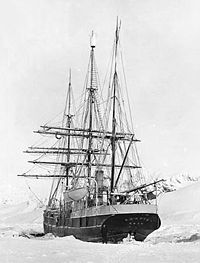
The
Bruce had spent most of the 1890s engaged on expeditions to the
The expedition has been described as "by far the most cost-effective and carefully planned scientific expedition of the Heroic Age." Despite this, Bruce received no formal honour or recognition from the British Government, and the expedition's members were denied the prestigious Polar Medal despite vigorous lobbying. After the SNAE, Bruce led no more Antarctic expeditions, although he made regular Arctic trips. His focus on serious scientific exploration was out of fashion with his times, and his achievements, unlike those of the polar adventurers Scott, Shackleton and Amundsen, soon faded from public awareness. The SNAE's permanent memorial is the Orcadas weather station, which was set up in 1903 as "Omond House" on Laurie Island, South Orkneys, and has been in continuous operation ever since.
Selected articles 46
Portal:Scotland/Selected articles/46

Jarlshof (/ˈjɑːrlzhɒf/ YARLZ-hof) is the best-known prehistoric archaeological site in Shetland, Scotland. It lies in Sumburgh, Mainland, Shetland and has been described as "one of the most remarkable archaeological sites ever excavated in the British Isles". It contains remains dating from 2500 BC up to the 17th century AD.
The
The site is in the care of
Selected articles 47
Portal:Scotland/Selected articles/47

Since the
Selected articles 48
Portal:Scotland/Selected articles/48
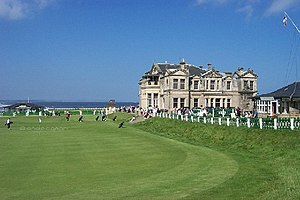
Golf in Scotland was first recorded in the Scottish late Middle Ages, and the modern game of golf was first developed and established in the country. The game plays a key role in the national sporting consciousness.
To many golfers, the
, and Scots golfers have the most victories at the Open at 42 wins, one ahead of the United States.Although golf is often seen as an
Selected articles 49
Portal:Scotland/Selected articles/49

The Bell Rock Lighthouse, off the coast of Angus, Scotland, is the world's oldest surviving sea-washed lighthouse. It was built between 1807 and 1810 by Robert Stevenson on the Bell Rock (also known as Inchcape) in the North Sea, 11 miles (18 km) east of the Firth of Tay. Standing 35 metres (115 ft) tall, its light is visible from 35 statute miles (56 km) inland.
The masonry work on which the lighthouse rests was constructed to such a high standard that it has not been replaced or adapted in 200 years. The lamps and reflectors were replaced in 1843; the original ones are now in the lighthouse at Cape Bonavista, Newfoundland, where they are currently on display. The working of the lighthouse has been automated since 24 October 1988. The Northern Lighthouse Board, which has had its headquarters at 84 George Street in Edinburgh since 1832, remotely monitors the light.
The lighthouse previously operated in tandem with a shore station, the Bell Rock Signal Tower, built in 1813 at the mouth of Arbroath harbour. Today this building houses the Signal Tower Museum, a visitor centre that offers a detailed history of the lighthouse.
Because of the engineering challenges that were overcome to build the lighthouse, it has been described as one of the Seven Wonders of the Industrial World.
Selected articles 50
Portal:Scotland/Selected articles/50

Likely founded in the 12th century and dedicated to
Selected articles 51
Portal:Scotland/Selected articles/51

The earliest known settlements around Dunfermline probably date to the
Selected articles 52
Portal:Scotland/Selected articles/52

Aberdour Castle is in the village of Easter Aberdour, Fife, Scotland. Parts of the castle date from around 1200, making Aberdour one of the two oldest datable standing castles in Scotland, along with Castle Sween in Argyll, which was built at around the same time.
The earliest part of the castle was a modest
The castle is largely the creation of the Douglas Earls of Morton, who held Aberdour from the 14th century. The earls used Aberdour as a second home until 1642, when their primary residence, Dalkeith House, was sold. A fire in the late 17th century was followed by some repairs, but in 1725 the family purchased nearby Aberdour House, and the medieval castle was allowed to fall into decay. Today, only the 17th-century wing remains roofed, while the tower has mostly collapsed. Aberdour Castle is now in the care of Historic Environment Scotland, and is open to the public all year.
Selected articles 53
Portal:Scotland/Selected articles/53

When Stirling was temporarily under Anglo-Saxon sway, according to a 9th-century legend, it was attacked by Danish invaders. The sound of a wolf roused a sentry, however, who alerted his garrison, which forced a Viking retreat. This led to the wolf being adopted as a symbol of the town as is shown on the 1511 Stirling Jug. The area is today known as Wolfcraig. Even today the wolf appears with a goshawk on the council's coat of arms along with the recently chosen motto: "Steadfast as the Rock".
Once the capital of Scotland, Stirling is visually dominated by
Selected articles 54
Portal:Scotland/Selected articles/54

The
The three main global university rankings (QS, THE, and ARWU) all place Edinburgh within their respective top 40. It is a member of several associations of research-intensive universities, including the Coimbra Group, League of European Research Universities, Russell Group, Una Europa, and Universitas 21. In the fiscal year ending 31 July 2023, it had a total income of £1.341 billion, of which £339.5 million was from research grants and contracts. It has the third-largest endowment in the UK, behind only Cambridge and Oxford. The university occupies five main campuses in the city of Edinburgh, which include many buildings of historical and architectural significance such as those in the Old Town.
Edinburgh is the seventh-largest university in the UK by enrolment and receives over 75,000 undergraduate applications per year, making it the second-most popular university in the UK by volume of applications. Edinburgh had the seventh-highest average UCAS points amongst British universities for new entrants in 2021. The university continues to have links to the royal family, having had Prince Philip, Duke of Edinburgh as its chancellor from 1953 to 2010 and Anne, Princess Royal since March 2011.
Selected articles 55
Portal:Scotland/Selected articles/55
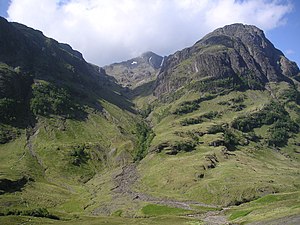
A 2010 review by Scottish Natural Heritage into the special qualities of Scotland's National scenic areas listed the "soaring, dramatic splendour of Glen Coe", and "the suddenness of the transition between high mountain pass and the lightly wooded strath" as being of note. The review also described the journey through the glen on the main A82 road as "one of the classic Highland journeys". The main settlement is the village of Glencoe located at the foot of the glen.
On 13 February 1692, in the aftermath of the
.Selected articles 56
Portal:Scotland/Selected articles/56

Outside of Scotland, tartan is sometimes also known as "plaid" (particularly in North America); however, in Scotland, a plaid is a large piece of tartan cloth which can be worn several ways.
Traditional tartan is made with alternating bands of coloured (pre-dyed) threads woven in usually matching warp and weft in a simple 2/2 twill pattern. Up close, this pattern forms alternating short diagonal lines where different colours cross; from further back, it gives the appearance of new colours blended from the original ones. The resulting blocks of colour repeat vertically and horizontally in a distinctive pattern of rectangles and lines known as a sett.
Selected articles 57
Portal:Scotland/Selected articles/57

The wars of Scottish Independence were a series of military campaigns fought between the Kingdom of Scotland and the Kingdom of England in the late 13th and early 14th centuries.
The First War (1296–1328) began with the English invasion of Scotland in 1296 and ended with the signing of the Treaty of Edinburgh–Northampton in 1328. The Second War (1332–1357) began with the English-supported invasion by Edward Balliol and the "Disinherited" in 1332 and ended in 1357 with the signing of the Treaty of Berwick. The wars were part of a great crisis for Scotland, and the period became one of the most defining times in its history. At the end of both wars, Scotland retained its status as an independent state. The wars were important for other reasons, such as the emergence of the longbow as a key weapon in medieval warfare.
King
Selected articles 58
Portal:Scotland/Selected articles/58

Begun in around 1240 by John De Vaux, the castle was heavily damaged during the
Selected articles 59
Portal:Scotland/Selected articles/59

The
The bagpipe of any kind is first attested in Scotland around 1400. The earliest references to bagpipes in Scotland are in a military context, and it is in that context that the great Highland bagpipe became established in the British military and achieved the widespread prominence it enjoys today, whereas other bagpipe traditions throughout Europe, ranging from Portugal to Russia, almost universally went into decline by the late 19th and early 20th century.
Though widely famous for its role in military and civilian pipe bands, the great Highland bagpipe is also used for a solo virtuosic style called pìobaireachd, ceòl mòr, or simply pibroch.Through development over the centuries, the great Highland bagpipes probably reached something like their distinctive modern form in the 18th century.
Though popular belief sets varying dates for the introduction of bagpipes to Scotland, concrete evidence is limited until approximately the 15th century. One clan still owns a remnant of a set of bagpipes said to have been carried at the Battle of Bannockburn in 1314, though the veracity of this claim is debated. There are many ancient legends and stories about bagpipes which were passed down through minstrels and oral tradition, whose origins are now lost. However, textual evidence for Scottish bagpipes is more definite in 1396, when records of the Battle of the North Inch of Perth reference "warpipes" being carried into battle. These references may be considered evidence as to the existence of particularly Scottish bagpipes, but evidence of a form peculiar to the Highlands appears in a poem written in 1598 and later published in The Complaynt of Scotland which refers to several types of pipe, including the Highland: "On hieland pipes, Scotte and Hybernicke / Let heir be shraichs of deadlie clarions."
Selected articles 60
Portal:Scotland/Selected articles/60

The town is home to the University of St Andrews, the third oldest university in the English-speaking world and the oldest in Scotland. It was ranked as the best university in the UK by the 2022 Good University Guide, which is published by The Times and The Sunday Times. According to other rankings, it is ranked as one of the best universities in the United Kingdom.
The town is named after
St Andrews is also known globally as the "

